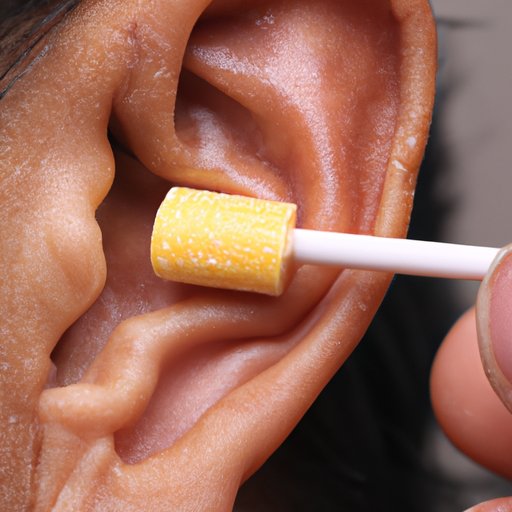
I. Introduction
Earwax, also known as cerumen, is a naturally produced substance in the ear canal that helps protect and lubricate the ear. However, excessive buildup of earwax can lead to hearing problems, infections, and discomfort. In this article, we will explore different ways to safely and effectively clean out earwax at home.
II. Traditional way of cleaning ear wax
The traditional method of cleaning earwax involves using cotton swabs or soft cloths to remove the wax from the ear. However, it is essential to be gentle when cleaning your ears to avoid injury or infection. While cotton swabs can clean the outer ear, they should never be inserted into the ear canal as they can push the wax deeper inside.
Pros of using cotton swabs or soft cloths include:
- Readily accessible and affordable
- Can be easily used at home
Cons of using cotton swabs or soft cloths include:
- Not suitable for cleaning deep inside the ear canal
- Potential risk of injury or infection if not used correctly
III. Using ear drops to soften ear wax
Eardrops are a safe and effective way to soften earwax, making it easier to clean. Eardrops contain lubricants or enzymes that break down the wax and allow it to be removed more easily.
Here are some simple instructions on how to use ear drops:
- Lie down with the affected ear facing up
- Administer a few drops of the solution into the ear canal
- Gently massage the ear for a few minutes
- Allow the solution to work for a few minutes before tilting your head to let it drain out
- Use a soft cloth to clean the outer ear
The benefits of using ear drops include:
- Can soften and break down earwax effectively
- Easy to use and readily available over the counter
Potential risks or side effects of using ear drops include:
- Allergic reactions or irritation
- May not be suitable for people with certain medical conditions or who have a perforated eardrum
IV. Seeking professional help
In some cases, it is necessary to seek professional help for earwax removal. A qualified healthcare provider can use specialized instruments or techniques to remove the wax safely.
Here’s what to expect when seeking professional help:
- Visual examination of the ear to determine the location and severity of earwax buildup
- Use of specialized instruments like suction devices or curettes to remove the wax
- May use ear drops before the procedure to soften the wax
Situations when it’s necessary to seek professional help include:
- Severe ear pain or discomfort
- Complete blockage of the ear canal
- Signs of infection like discharge or swelling
Some benefits of seeking professional help include:
- Safe and effective removal of earwax
- Reduced risk of complications like injury or infection
V. Home remedies for earwax removal
There are several home remedies that can be used to remove earwax effectively. These remedies use natural ingredients that are safe and readily available.
Examples of useful home remedies include:
- Olive oil: Warm a few drops of olive oil and administer them to the ear, allow the mixture to work for a few minutes before draining
- Hydrogen peroxide: Mix equal parts hydrogen peroxide and water and carefully administer a few drops to the affected ear
- Warm water: Flush the ear canal with warm water using a bulb syringe or spray bottle
The effectiveness of these remedies depends on the individual and the severity of the earwax buildup. It is essential to follow instructions carefully and avoid pushing wax deeper into the ear.
Potential risks or side effects of using home remedies include:
- Misuse or overuse can lead to injury or infection
- May not be effective for all individuals or types of earwax buildup
VI. Tips for preventing earwax buildup
Preventing earwax buildup is essential to maintaining ear health. Here are some helpful tips:
- Avoid inserting foreign objects into the ear like cotton swabs or bobby pins
- Use ear protection when swimming, showering, or in dusty environments
- Schedule regular checkups with your healthcare provider to monitor ear health
- Limit the use of earbuds or headphones that can push earwax deeper into the ear canal
VII. Conclusion
Cleaning out earwax is a necessary part of ear health maintenance. There are many different methods available to do so safely and effectively. It is important to remember to be gentle, follow instructions carefully and seek professional help when necessary. Giving attention to your ears is essential in maintaining your hearing ability and overall well-being.





